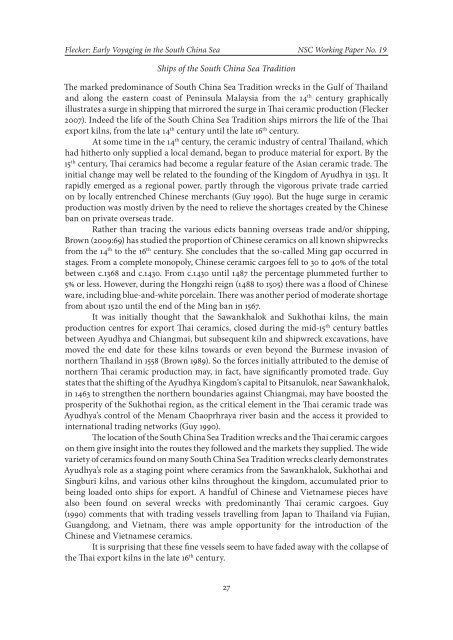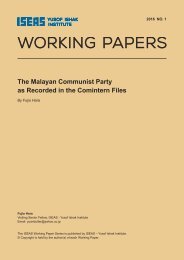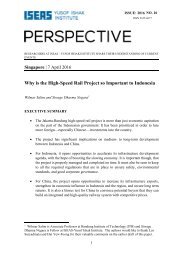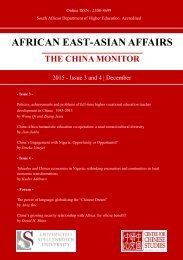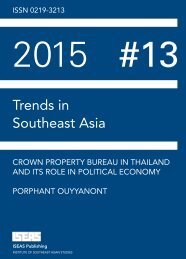NO.19
nscwps19_early_voyaging_south_china_sea_implications_territorial_claims
nscwps19_early_voyaging_south_china_sea_implications_territorial_claims
Create successful ePaper yourself
Turn your PDF publications into a flip-book with our unique Google optimized e-Paper software.
Flecker: Early Voyaging in the South China Sea NSC Working Paper No. 19Ships of the South China Sea TraditionThe marked predominance of South China Sea Tradition wrecks in the Gulf of Thailandand along the eastern coast of Peninsula Malaysia from the 14 th century graphicallyillustrates a surge in shipping that mirrored the surge in Thai ceramic production (Flecker2007). Indeed the life of the South China Sea Tradition ships mirrors the life of the Thaiexport kilns, from the late 14 th century until the late 16 th century.At some time in the 14 th century, the ceramic industry of central Thailand, whichhad hitherto only supplied a local demand, began to produce material for export. By the15 th century, Thai ceramics had become a regular feature of the Asian ceramic trade. Theinitial change may well be related to the founding of the Kingdom of Ayudhya in 1351. Itrapidly emerged as a regional power, partly through the vigorous private trade carriedon by locally entrenched Chinese merchants (Guy 1990). But the huge surge in ceramicproduction was mostly driven by the need to relieve the shortages created by the Chineseban on private overseas trade.Rather than tracing the various edicts banning overseas trade and/or shipping,Brown (2009:69) has studied the proportion of Chinese ceramics on all known shipwrecksfrom the 14 th to the 16 th century. She concludes that the so-called Ming gap occurred instages. From a complete monopoly, Chinese ceramic cargoes fell to 30 to 40% of the totalbetween c.1368 and c.1430. From c.1430 until 1487 the percentage plummeted further to5% or less. However, during the Hongzhi reign (1488 to 1505) there was a flood of Chineseware, including blue-and-white porcelain. There was another period of moderate shortagefrom about 1520 until the end of the Ming ban in 1567.It was initially thought that the Sawankhalok and Sukhothai kilns, the mainproduction centres for export Thai ceramics, closed during the mid-15 th century battlesbetween Ayudhya and Chiangmai, but subsequent kiln and shipwreck excavations, havemoved the end date for these kilns towards or even beyond the Burmese invasion ofnorthern Thailand in 1558 (Brown 1989). So the forces initially attributed to the demise ofnorthern Thai ceramic production may, in fact, have significantly promoted trade. Guystates that the shifting of the Ayudhya Kingdom’s capital to Pitsanulok, near Sawankhalok,in 1463 to strengthen the northern boundaries against Chiangmai, may have boosted theprosperity of the Sukhothai region, as the critical element in the Thai ceramic trade wasAyudhya’s control of the Menam Chaoprhraya river basin and the access it provided tointernational trading networks (Guy 1990).The location of the South China Sea Tradition wrecks and the Thai ceramic cargoeson them give insight into the routes they followed and the markets they supplied. The widevariety of ceramics found on many South China Sea Tradition wrecks clearly demonstratesAyudhya’s role as a staging point where ceramics from the Sawankhalok, Sukhothai andSingburi kilns, and various other kilns throughout the kingdom, accumulated prior tobeing loaded onto ships for export. A handful of Chinese and Vietnamese pieces havealso been found on several wrecks with predominantly Thai ceramic cargoes. Guy(1990) comments that with trading vessels travelling from Japan to Thailand via Fujian,Guangdong, and Vietnam, there was ample opportunity for the introduction of theChinese and Vietnamese ceramics.It is surprising that these fine vessels seem to have faded away with the collapse ofthe Thai export kilns in the late 16 th century.27


